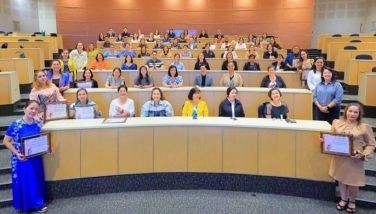A New Era In Biodiversity Management
April 29, 2007 | 12:00am
 News About The Environment, No Matter How Relevant To The the nation’s interest, is inherently bland.
News About The Environment, No Matter How Relevant To The the nation’s interest, is inherently bland.
Compared to the drama of corruption scandals or the loud roar of election controversies, the urgency of saving the country’s remaining endemic species simply cannot excite the public in the same way.
Yet, there is perhaps more drama in the high seas as the last of the predatory fishes fight for their last breath before a dynamite blast drives them to extinction. Definitely, there is a story to tell in a remote shoreline as an ageing sea turtle crawls back to shore for the last time before it ends up as a turtle soup in a rich man’s table or as a tortoise shell trinket in a souvenir shop.
What more could be more dramatic than an eagle’s last soar in the sky before it is felled by a hunter’s bullet? The heart of darkness lurks in the most beautiful of places, in the gentlest embrace of the calmest of winds.
But for Conservation International Philippines, a US-based international organization whose mission is to conserve the earth’s living heritage and demonstrate that human societies can live harmoniously with nature, all is not lost. A new strategy in biodiversity management is shaping up.
First the facts: The Philippines has more than 20,000 endemic species and is one of the 17 countries which collectively claim two-thirds of the earth’s biological diversity within their boundaries.
These 17 countries occupy only 2.5 percent of the earth’s land area but host more than 50 percent of the species of the entire world. Our country’s wealth really lies in the richness of our lands and seas and the abundance life forms in our midst.
Yet, according to Romeo Trono, CI Philipines’ country executive director, we are fast losing our endemic species to wildlife hunting, illegal logging, land conversions, mining operations, cyanide and dynamite fishing, urbanization, pollution and oil spills, among other environmental aggressions.
Familiar woes, typical gripes.
But the depletion of our marine resources is alarming. The Philippines is actually one of 34 global biodiversity hotspots, which means that the nation’s high biodiversity and endemism is under a high level of threat.
Trono shares, for example, that there are 491 critically endangered species locally and only five percent of our live coral cover remains intact.
"The problem is enormous," says Trono. "Not one organization can succeed singlehandedly in any conservation effort."
Yet, this environmental activist believes that there is hope because now, more than ever, there is greater collaboration among the different sectors working for the environment.
One can hardly call Trono an activist, although his cause and that of CI Philippines is the stuff that sends students, militant organizations, academicians and intellectuals to protest marches.
"Not many people will like what I have to say but I think the government is on the right track and that Environment Secretary Angelo Reyes is really doing a good job," Trono says.
For one, he says the government is now reaching out to various stakeholders of the environment–non-government organizations (NGOs), non-profit foundations, local government units (LGUs), the private sector and even local communities.
"Now they are talking, forming partnerships and alliances, and working together for a common cause," he says.
According to Trono, this proactive, constructive approach is more productive in solving problems.
CI Philippines, for one, is one of the environmental organizations that has adapted a non-adversarial stance against the government and environmental offenders and a non-competitive approach to other environmental players.
"We are in a new era of biodiversity management," he says. "What we really need is to be interconnected with each other and to address the issues in a holistic manner."
The three major problems of the marine ecosystem–destruction of the marine habitat, lack of enforcement policies on marine development and ineffective marine planning–are intertwined and not one organization can possibly solve it.
One cannot talk, for example, of eradicating dynamite fishing if one does not provide alternative sources of livelihood to the fisherfolk, Trono says.
It is also not enough to aim the gun at illegal wildlife hunting and trading and not do something about water pollution that is probably threatens sea life more.
"It is how we manage our relationships and our projects that our work could be effective," Trono says.
CI is currently focused on identifying key biodiversity areas (KBAs) in the Philippines, which should receive the highest priority for immediate conservation.
A total of 128 KBAs had been identified throughout the country from as far north as the Batanes islands to as far south as Sibutu and Tumindao Islands in the Sulu-Sulawesi area.
Environmental groups, says Trono, can use the list and profile of KBAs for targeting conservation action.
What can ordinary people do to help in biodiversity conservation?
First, says Trono, the public should have an awareness of the problem. And this is really the expertise of organizations like Green Peace and the World Wildlife Fund which are strong in media advocacy.
Educating the public on the interrelatedness of health, population, poverty and development issues to the problems of the environment is the first step.
Second, ordinary households should consciousciously practice solid waste management. If not properly disposed, garbage could end up in rivers and seas and eventually kill marine life.
Third, ordinary people can actually help the government do its work through volunteerism.
Trono cites the case of a local community in Anilao, Batangas, which is a famous diving area. For every dive, divers pay a certain amount which goes to a coastal resources management fund, which in turn is used to fund the Bantay Dagat program in coastal communities. NGOs provide logistical support to the project while the local government provides the policy framework through municipal ordinances.
"This is the kind of project where everybody benefits by working together," Trono says.
Another successful project, he shares, was the watershed conservation effort of the commuity in Peñablanca, Tuguegarao where local businesses such as hotels, restaurants, resorts, and gas stations contribute a percentage of their daily sales to fund the conservation of its watershed in the Pinacanauan River, where the water district sources its water supply.
"They found out that when the water supply is low, everybody is affected, not just households. Farms need water for irrigation, factories need stable water supply for their operations. By contributing a small amount for watershed management, each one is indirectly helping preserve animal species which live in the watershed area," Trono explains.
Trono says that he is also happy with the interest the private sector is showing to conservation efforts.
Though most corporate social responsibility programs geared toward coastal resources management or environmental conversation in general are focused on traditional issues, Trono says big businesses can create an impact because they have the resources to hel.
He cites First Gen Corp., an independent power generation company, as an example of how big business can help.
First Gen, Trono says, committed $1 million for the conservation of the Verde Island Passage, which was dubbed as the "center of the center" of marine diversity and home to an estimated 1,736 marine species.
Trono says that CI Philippines can also help big businesses implement their corporate environmental programs.
"We can work with mining organizations, for example, and help them implement environmental policies that can avert environmental disasters," he says. "Let’s accept it, we cannot really eradicate mining, what we can do is work closely with mining companies and communities and help them adopt the best practices in responsible mining," he stresses.
Perhaps what CI Philippines is trying to do is blurring the traces of divisiveness that had driven many environmental groups in the past so that at least one more specie could be saved from extinction, one step at a time.
BrandSpace Articles
<
>
- Latest
- Trending
Trending
Latest
Trending
Latest
Recommended
















